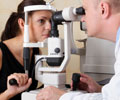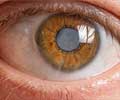Study provide new warnings on risks for melanoma of the eye as well as reassurance on infection risks following cataract surgery.
Studies published in the March issue of Ophthalmology, the journal of the American Academy of Ophthalmology, provide new warnings on risks for melanoma of the eye as well as reassurance on infection risks following cataract surgery.
Skin Moles May Indicate Higher Eye Melanoma Risk It is well known that people with light skin and numerous moles and freckles---which develop when skin is over-exposed to UV light--are at higher risk for skin cancer (cutaneous melanoma). But the evidence was less clear on whether moles and freckles also indicate a higher risk of uveal melanoma, cancer of the eye's iris, ciliary body, or choroid. The iris is the colored area in the front of the eye, and the ciliary body and choroid supply blood flow and perform other vital functions deep within the eye. Some earlier studies found a relationship between moles/freckles and higher uveal melanoma rates, but others did not.A research team led by Ezekiel Weis, MD, MPH, Department of Ophthalmology, University of Alberta, Canada, performed a meta-analysis that adjusted for factors that might have skewed results of earlier studies. His team's analysis showed associations between atypical moles (which appear different in shape or color from common moles), common moles, freckles, moles on the iris, and risk of uveal melanoma. For example, people with atypical moles are 2.8 times more likely to develop uveal melanoma than people with no such moles. This study suggests that doctors need to be extra vigilant when patients have numerous moles or freckles and that further research into the role of UV light in susceptible populations is required exposure.
Uveal cancer occurs in 6 persons per million annually and is the most common non-skin melanoma in the United States. It most often strikes people 70 or older who have light skin and eye color and a tendency to sunburn; these risk factors were identified by Dr. Weis and colleagues in earlier research. Caucasians are most susceptible, and risk levels decline as skin pigmentation increases across ethnic groups. Uveal melanoma may also result when melanoma from another site metastasizes. In the early stages the disease usually has no symptoms. Although treatment is available, the mortality rate remains high, especially when the ciliary body or choroid is involved."We want to confirm risk factors that people will be able to modify, so we'll have a better chance of preventing uveal cancer, and we want to know which patients are most susceptible so we can begin treatment, when needed, as early as possible," said Dr. Weis. "Our study points to an interaction of genetic susceptibility and an environmental insult in the form of UV exposure."
Infection Rates Low with New Cataract Surgery TechniquesA large study by Canadian researchers has found that endophthalmitis, a serious infection of the inner eye, continues to be rare following cataract surgery. Because surgical techniques and patient selection criteria have evolved rapidly in the past several years, the researchers wanted to learn whether infection risks were changing as a result. The largest previous study, completed in 2001 using records of half-million United States Medicare cataract patients, had documented very low infection rates.
Chaim M. Bell, MD, PhD, and Wendy Hatch OD, MSc, University of Toronto, Canada, and their colleagues reviewed records for more than 440,000 consecutive cataract surgeries performed in surgical facilities in Ontario, Canada, between April 2002 and March 2006. Facilities where more than 50 cataract surgeries were performed annually were included. To estimate infection rates, the study tracked post-operative procedures to treat suspected infections that occurred within 14 days of cataract surgery.
The overall rate of suspected acute endophthalmitis was very low: 1.4 per 1,000 surgeries. Patients who required procedures to correct ruptures of their lens capsule, the structure that contains the eye's lens, during their cataract surgery were about 10 times more likely to develop suspected infection, but fewer than 1 in 200 sustained such a rupture. The highest rate of suspected endophthalmitis occurred in patients over age 85 (2.18 per 1,000). Men were at somewhat higher risk than women (1.7 vs. 1.19 per 1,000). No differences in rates were found between patients living in rural vs. non-rural settings, nor were differences noted among socioeconomic groups. No upward or downward trend in suspected endophthalmitis related to cataract surgery was evident during the study period.
Advertisement
SRM













